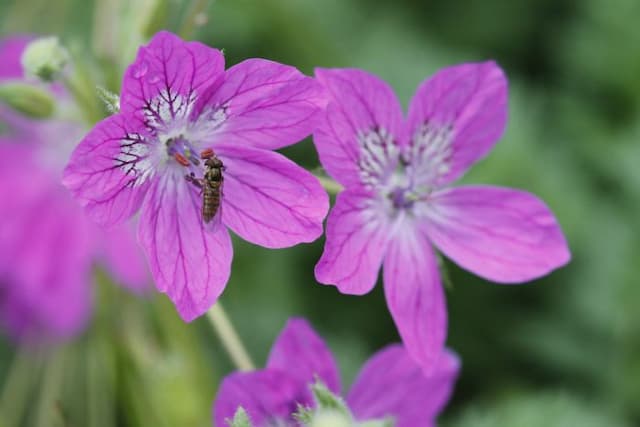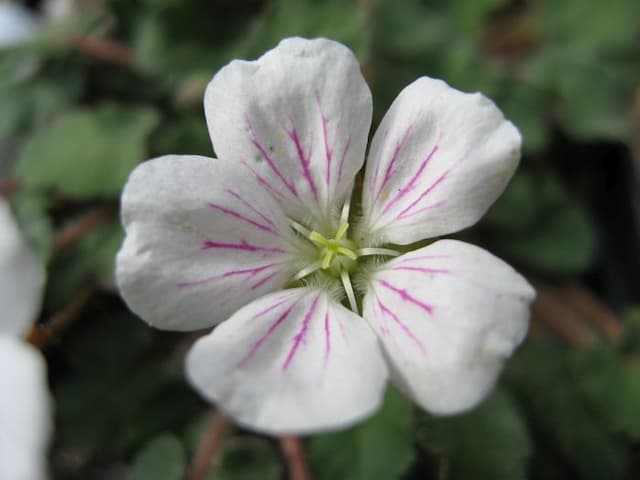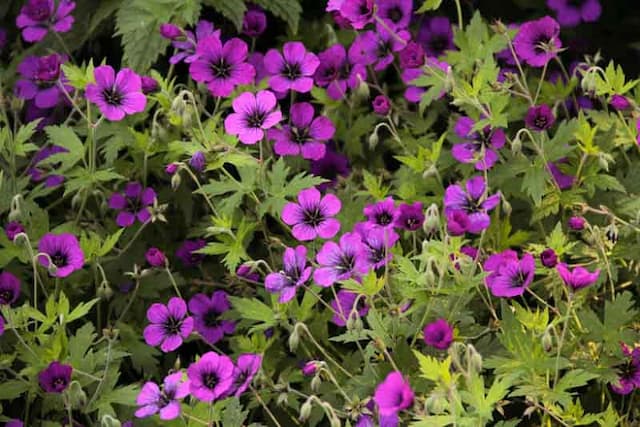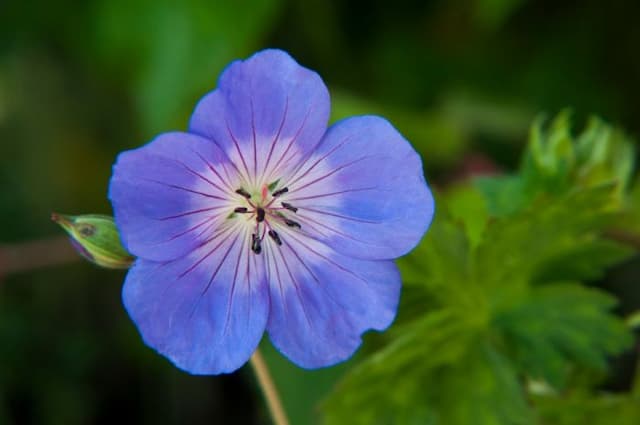Geranium Pelargonium 'Rosita' (Dw/d)

ABOUT
Pelargonium 'Rosita' is a variety of geranium known for its vibrant and beautiful flowers. It produces clusters of eye-catching blossoms that are typically bright pink with darker pink or magenta markings on the petals, giving them a unique and striking appearance. The flower heads are rounded and composed of numerous individual blooms that create a lush display on top of the plant. The foliage of this geranium is also attractive, usually a rich green color, with leaves that are rounded with a soft, scalloped edge. Each leaf is veined and may have a slight zonal pattern, which is a darker color on the upper surface of the leaf, adding further interest to the plant's overall look. As a variety of geranium, Pelargonium 'Rosita' is commonly grown as an ornamental plant in gardens and containers. It's often praised for both its floral display and the aromatic foliage, which can release a pleasant fragrance when brushed or crushed. This decorative quality makes it a popular choice for gardeners looking to add both color and scent to their outdoor or indoor spaces.
About this plant
 Names
NamesFamily
Geraniaceae.
Synonyms
Rose Geranium, Sweet Scented Geranium.
Common names
Pelargonium 'Rosita' (Dw/d).
 Toxicity
ToxicityTo humans
Geraniums, including the Pelargonium 'Rosita', are not considered highly toxic to humans. However, if ingested, they may cause mild irritation to the mouth, throat, and gastrointestinal system. Symptoms could include nausea, vomiting, and diarrhea but are generally not severe. Most people will not experience any significant adverse effects from handling or unintentionally ingesting the plant. It's always prudent to keep plants out of reach of small children who might chew on them.
To pets
Geraniums are known to be toxic to pets, including dogs and cats. If a pet ingests geranium, it might display symptoms such as vomiting, anorexia, depression, and dermatitis. In most cases, the toxicity is considered mild to moderate. However, it is important to keep an eye on your pets and prevent them from ingesting the plant. If you suspect your pet has ingested geranium and is showing adverse symptoms, it's advisable to consult a veterinarian.
 Characteristics
CharacteristicsLife cycle
Perennials
Foliage type
Evergreen
Color of leaves
Green
Flower color
Pink
Height
1 feet 2 inches (35 centimeters)
Spread
1 feet 2 inches (35 centimeters)
Plant type
Herb
Hardiness zones
10
Native area
South Africa
Benefits
 General Benefits
General Benefits- Easy to Grow - Pelargonium 'Rosita' is known for being low-maintenance and easy to care for, making it ideal for gardeners of all skill levels.
- Long Blooming Season - Offers a long blooming period that can extend from spring to fall, providing a lasting display of flowers.
- Drought Tolerant - Once established, it is quite drought-resistant, reducing the need for frequent watering.
- Attracts Pollinators - The flowers attract beneficial pollinators like bees and butterflies, helping to support local ecosystems.
- Versatile in Landscaping - Can be used in a variety of settings such as borders, containers, and as a bedding plant, providing flexibility in garden design.
- Colorful Foliage - The leaves can add a touch of color to the garden even when the plant is not in bloom.
- Fragrance - Some varieties have a pleasant scent which can add an aromatic dimension to gardens and outdoor spaces.
- Can Be Overwintered - In colder climates, it can be overwintered indoors, allowing gardeners to enjoy the plant year after year.
 Medical Properties
Medical PropertiesThis plant is not used for medical purposes.
 Air-purifying Qualities
Air-purifying QualitiesThis plant is not specifically known for air purifying qualities.
 Other Uses
Other Uses- Plant Dye: Pelargonium leaves and flowers can be used to produce a natural dye for fabric, wool, and paper, offering a range of colors depending on the mordant used.
- Insect Repellent: Some people use the scented leaves of geraniums to repel mosquitoes and other insects by rubbing the leaves on their skin or placing them in areas where insect presence is unwanted.
- Aromatherapy: The essential oil derived from geraniums is often used in aromatherapy for its potential to reduce stress and anxiety through its calming fragrance.
- Flavoring Agent: The edible flowers and leaves can add a citrus or rose-like flavor to desserts, jellies, ice creams, or teas.
- Garden Companion Planting: Geraniums can be interspersed with vegetables and other plants to help repel pests and attract beneficial insects, enhancing garden health.
- Photography: The vibrant flowers and textured leaves provide a picturesque quality that can be used by photographers as a subject or backdrop for macro photography.
- Art Supplies: The varied and vivid colors of geranium flowers are sometimes used by artists for creating natural pigments for paints.
- Educational Tool: Due to their ease of growth and care, geraniums can be used in educational settings to teach children about plant biology and gardening.
- Culinary Garnish: Fresh geranium petals can be used as a decorative and edible garnish on salads, cakes, and culinary dishes.
- Handmade Paper: Geranium leaves and petals can be included in the process of making handmade paper, adding texture and natural elements to the final product.
Interesting Facts
 Feng Shui
Feng ShuiThe Geranium is not used in Feng Shui practice.
 Zodiac Sign Compitability
Zodiac Sign CompitabilityThe Geranium is not used in astrology practice.
 Plant Symbolism
Plant Symbolism- Comfort: The cozy and soft appearance of the Pelargonium 'Rosita', commonly known as Geranium 'Rosita', can symbolize soothing presence and emotional comfort.
- Friendship: Geraniums in general are often associated with friendship, suggesting strong bonds and mutual understanding.
- Health: The 'Rosita' variety, with its lush foliage and vibrant blooms, can represent a wish for good health and vitality.
- Stability: The sturdy nature of Geranium 'Rosita' may be symbolic of stability and reliability in one's life.
- Positive Energy: With its bright colored flowers, Geranium 'Rosita' can signify the flow of positive energy and happiness.
 Water
WaterTo properly water a Geranium 'Rosita', ensure the soil is almost dry before watering, typically every 7 to 10 days depending on climate conditions. Provide a deep watering, using approximately 16 to 24 ounces of water for a standard 6 to 8-inch pot, ensuring it reaches the roots without waterlogging. During the active growing season in spring and summer, watering frequency may increase due to higher temperatures. In winter, reduce watering to prevent root rot, as the plant's growth slows down. Always check the top inch of soil for moisture before watering.
 Light
LightGeraniums, including 'Rosita', thrive best in bright, indirect sunlight. A spot near an east or west-facing window where it can receive gentle morning or afternoon sunlight is ideal. Protect the plant from harsh, direct midday sun to prevent leaf scorch, especially in hotter climates. Adequate light is essential for abundant flowering and healthy growth.
 Temperature
TemperatureGeranium 'Rosita' prefers temperatures between 65 to 75 degrees Fahrenheit during the day and should not be exposed to temperatures below 50 degrees Fahrenheit at night. It can survive briefly in temperatures as low as 30 degrees Fahrenheit but for optimal growth, maintaining a consistent temperature within the ideal range is recommended. Avoid drafts, sudden temperature changes, and protect the plant from frost.
 Pruning
PruningPrune Geranium 'Rosita' to encourage bushy growth and prolific flowering. Deadheading spent blooms and cutting back leggy stems can be done throughout the growing season. Perform more thorough pruning in early spring to shape the plant and remove any dead or damaged growth. Pruning every 8 to 12 weeks will help maintain an attractive form and promote new growth.
 Cleaning
CleaningAs needed
 Soil
SoilThe best soil mix for geraniums (Pelargonium 'Rosita') is well-draining, with a mix of peat, perlite, and compost. A slightly acidic to neutral pH of 6.0 to 7.0 is ideal for these plants to thrive.
 Repotting
RepottingGeraniums (Pelargonium 'Rosita') should be repotted annually to refresh the soil and accommodate root growth or when the plant looks crowded in its current container.
 Humidity & Misting
Humidity & MistingGeraniums (Pelargonium 'Rosita') prefer moderate humidity levels but are quite adaptable and can tolerate indoor humidity conditions without special treatment.
 Suitable locations
Suitable locationsIndoor
Place geranium in bright light, avoiding direct strong sun.
Outdoor
Plant in light shade or morning sun, and protect from strong afternoon rays.
Hardiness zone
10-11 USDA
 Life cycle
Life cycleThe life of the Pelargonium 'Rosita', commonly known as geranium 'Rosita', begins with the germination of seeds or rooting of cuttings in a warm, moist growing medium. Upon successful germination or rooting, the seedling or cutting enters a vegetative stage, involving the growth of leaves and stems as it matures. This is followed by the development of buds that bloom into characteristic flowers, which can be pink, red, purple, or white depending on the cultivar. Once flowering occurs, pollination may take place leading to the production of seeds within the dehiscent fruit known as a schizocarp. After seed dispersal or if cuttings are taken, the parent plant continues its growth cycle by entering a period of dormancy during colder months, or it may remain evergreen in mild climates. Finally, the plant may eventually reach a senescence phase, characterized by a decline in growth and vigor, which leads to the end of the plant's life cycle.
 Propogation
PropogationPropogation time
Spring-Early Summer
The most popular method of propagating Pelargonium 'Rosita', commonly known as a type of geranium, is through stem cuttings. This process typically takes place during late winter to early spring, just before active growth begins. To propagate, a healthy stem about 4 to 6 inches (10 to 15 centimeters) long is cut just below a node, making sure there are at least two sets of leaves on the cutting. The lower leaves are removed, and the cut end can be dipped in a rooting hormone to encourage root development. The cutting is then planted in a well-draining potting mix, watered lightly, and covered with a plastic bag to maintain humidity. It should be placed in bright, indirect light and kept at a temperature of around 70°F (21°C) until new growth indicates successful rooting.









![Cranesbill [Rothbury Gem]](/_next/image?url=https%3A%2F%2Fplants-admin.emdemapps.com%2Fimages%2Fplants%2F%2Fimages%2F604b6243984c2.png&w=640&q=75)